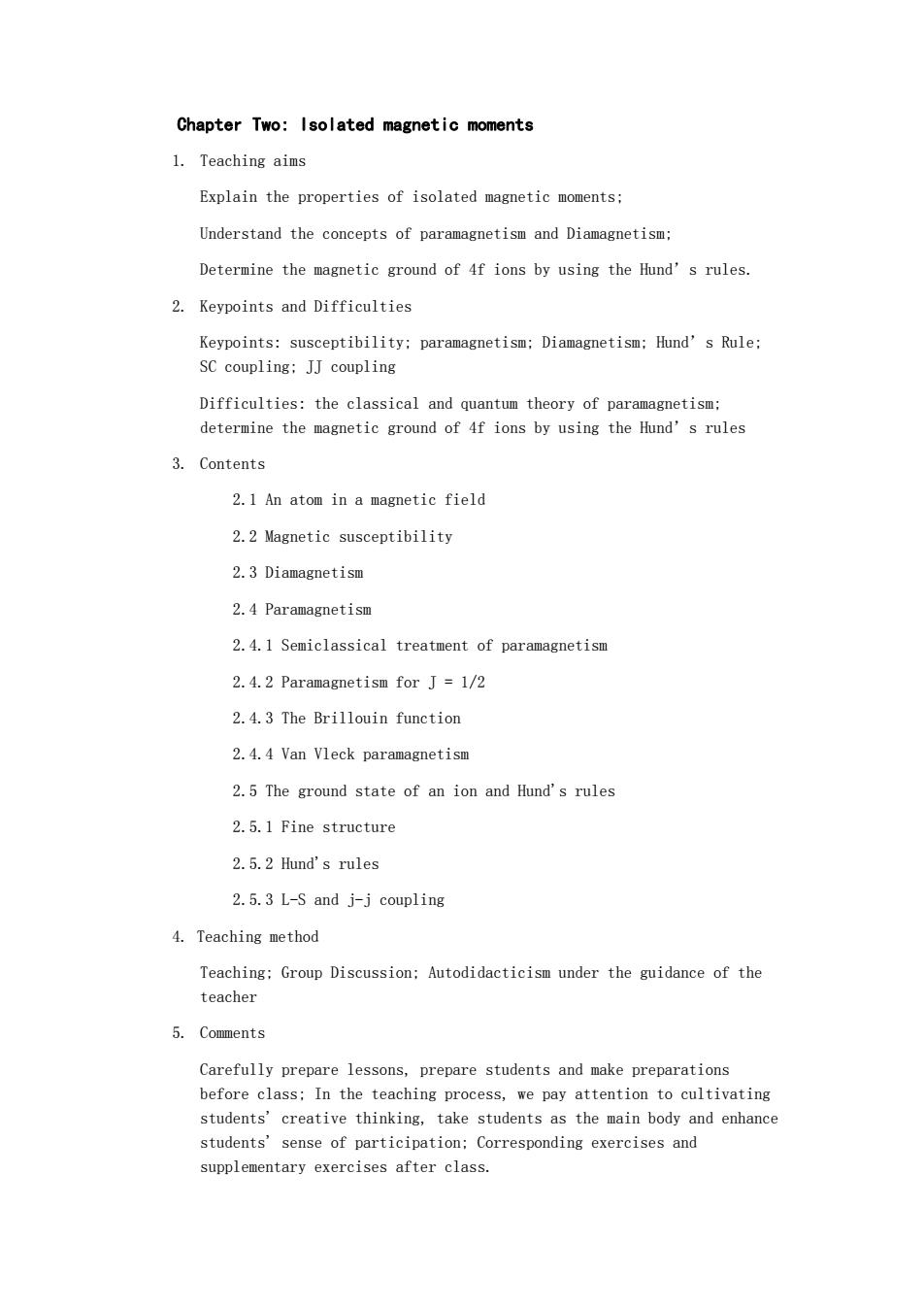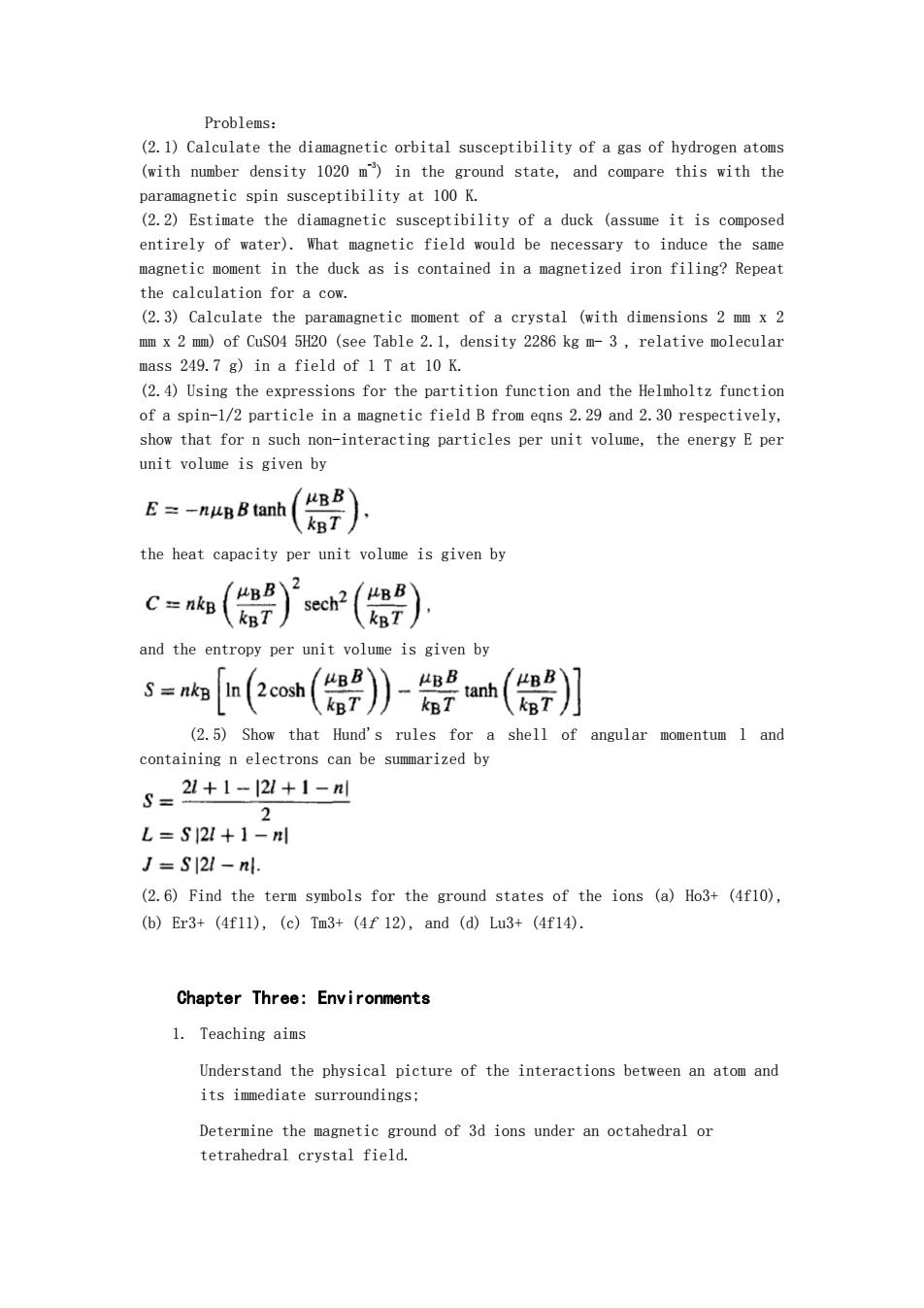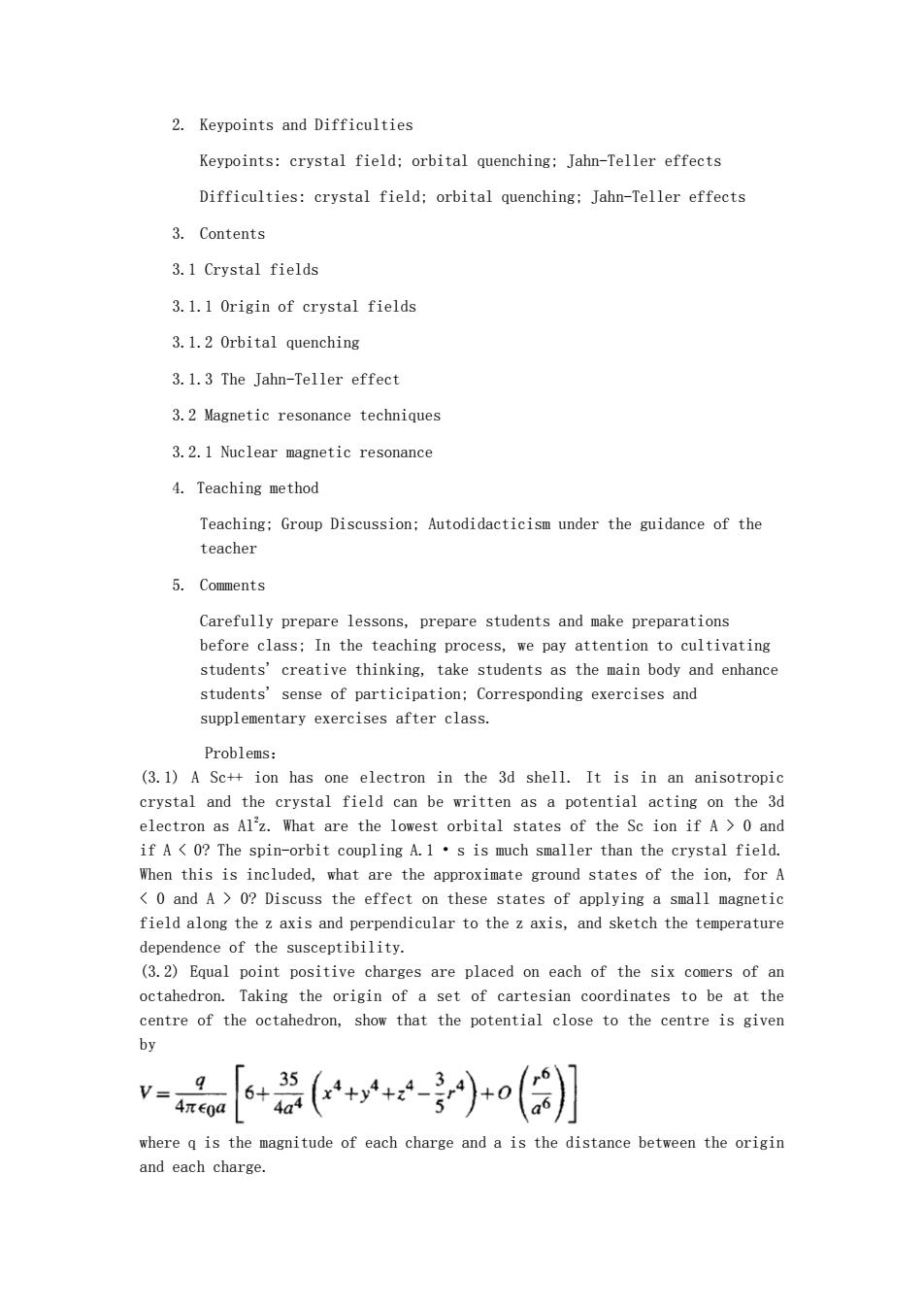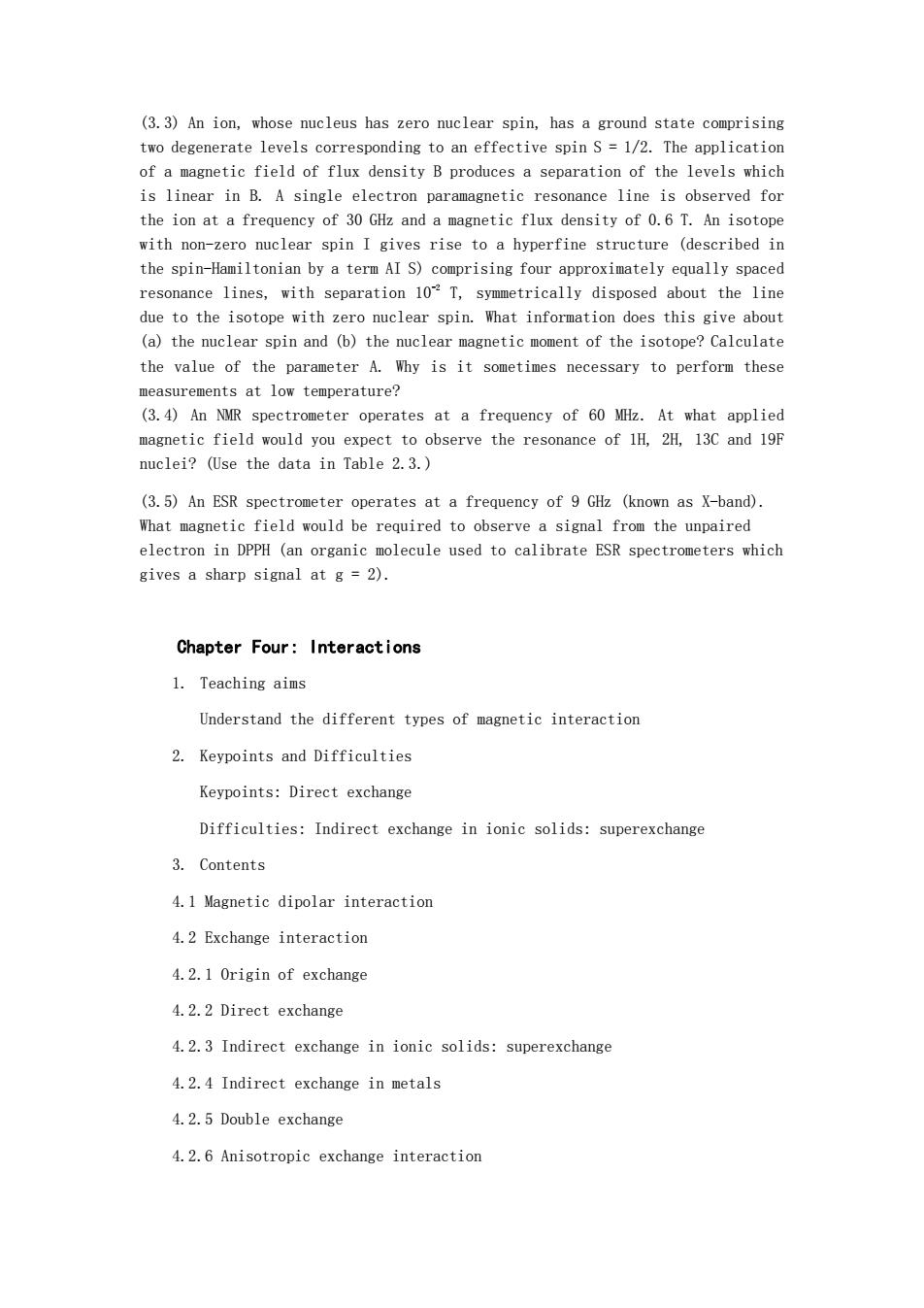
Chapter Two:Isolated magnetic moments 1.Teaching aims Explain the properties of isolated magnetic moments: Understand the concepts of paramagnetism and Diamagnetism; Determine the magnetic ground of 4f ions by using the Hund's rules 2.Keypoints and Difficulties Keypoints:susceptibility:paramagnetism:Diamagnetism:Hund's Rule: SC coupling:JJ coupling Difficulties:the classical and quantum theory of paramagnetism: determine the magnetic ground of 4f ions by using the Hund's rules 3.Contents 2.1 An atom in a magnetic field 2.2 Magnetic susceptibility 2.3 Diamagnetism 2.4 Paramagnetism 2.4.1 Semiclassical treatment of paramagnetism 2.4.2 Paramagnetism for J=1/2 2.4.3 The Brillouin function 2.4.4 Van Vleck paramagnetism 2.5 The ground state of an ion and Hund's rules 2.5.1Fine structure 2.5.2 Hund's rules 2.5.3 L-S and j-j coupling 4.Teaching method Teaching:Group Discussion:Autodidacticism under the guidance of the teacher 5.Comments Carefully prepare lessons,prepare students and make preparations before class:In the teaching process,we pay attention to cultivating students'creative thinking,take students as the main body and enhance students'sense of participation;Corresponding exercises and supplementary exercises after class
Chapter Two: Isolated magnetic moments 1. Teaching aims Explain the properties of isolated magnetic moments; Understand the concepts of paramagnetism and Diamagnetism; Determine the magnetic ground of 4f ions by using the Hund’s rules. 2. Keypoints and Difficulties Keypoints: susceptibility; paramagnetism; Diamagnetism; Hund’s Rule; SC coupling; JJ coupling Difficulties: the classical and quantum theory of paramagnetism; determine the magnetic ground of 4f ions by using the Hund’s rules 3. Contents 2.1 An atom in a magnetic field 2.2 Magnetic susceptibility 2.3 Diamagnetism 2.4 Paramagnetism 2.4.1 Semiclassical treatment of paramagnetism 2.4.2 Paramagnetism for J = 1/2 2.4.3 The Brillouin function 2.4.4 Van Vleck paramagnetism 2.5 The ground state of an ion and Hund's rules 2.5.1 Fine structure 2.5.2 Hund's rules 2.5.3 L-S and j-j coupling 4. Teaching method Teaching; Group Discussion; Autodidacticism under the guidance of the teacher 5. Comments Carefully prepare lessons, prepare students and make preparations before class; In the teaching process, we pay attention to cultivating students' creative thinking, take students as the main body and enhance students' sense of participation; Corresponding exercises and supplementary exercises after class

Problems: (2.1)Calculate the diamagnetic orbital susceptibility of a gas of hydrogen atoms (with number density 1020 m)in the ground state,and compare this with the entirely of water).What magnetic field would be necessary to induce the same magnetic moment in the duck as is contained in a magnetized iron filing?Repeat the calculation for a cow. (2.3)Calculate the mass 249.7 g)in a field of 1 T at 10 K. (2.4)Using the expressions for the partition function and the Helmholtz function of a spin-1/2 particle in a magnetic field B from eans 2.29 and 2.30 respectively, show that for such non-interacting particles per unit volume, the energy E pe unit volume is given by 公=-e8an(给)】 the heat capacity per unit volume is given by c(需}a(》) and the entropy per unit volume is given by s[(c(器)》-器m(e】 (2.5)Show that Hund's rules for a shell of angular momentum 1 and containing n electrons can be summarized by S=21+1-2☑+1-m L=S12l+1-m川 J=S121-nl. (2.6)Find the term symbols for the ground states of the ions (a)Ho3+(4f10), (b)Er3+(4f11),(c)Tm3+(4f12),and(d)Lu3+(4f14). Chapter Three:Environments 1.Teaching aims Understand the physical picture of the interactions between an atom and its immediate surroundings: Determine the magnetic ground of 3d ions under an octahedral or tetrahedral crystal field
Problems: (2.1) Calculate the diamagnetic orbital susceptibility of a gas of hydrogen atoms (with number density 1020 m-3) in the ground state, and compare this with the paramagnetic spin susceptibility at 100 K. (2.2) Estimate the diamagnetic susceptibility of a duck (assume it is composed entirely of water). What magnetic field would be necessary to induce the same magnetic moment in the duck as is contained in a magnetized iron filing? Repeat the calculation for a cow. (2.3) Calculate the paramagnetic moment of a crystal (with dimensions 2 mm x 2 mm x 2 mm) of CuSO4 5H2O (see Table 2.1, density 2286 kg m- 3 , relative molecular mass 249.7 g) in a field of 1 T at 10 K. (2.4) Using the expressions for the partition function and the Helmholtz function of a spin-1/2 particle in a magnetic field B from eqns 2.29 and 2.30 respectively, show that for n such non-interacting particles per unit volume, the energy E per unit volume is given by the heat capacity per unit volume is given by and the entropy per unit volume is given by (2.5) Show that Hund's rules for a shell of angular momentum l and containing n electrons can be summarized by (2.6) Find the term symbols for the ground states of the ions (a) Ho3+ (4f10), (b) Er3+ (4f11), (c) Tm3+ (4f 12), and (d) Lu3+ (4f14). Chapter Three: Environments 1. Teaching aims Understand the physical picture of the interactions between an atom and its immediate surroundings; Determine the magnetic ground of 3d ions under an octahedral or tetrahedral crystal field

2.Keypoints and Difficulties Keypoints:crystal field;orbital quenching:Jahn-Teller effects Difficulties:crystal field:orbital quenching:Jahn-Teller effects 3.Contents 3.1 Crystal fields 3.1.1 Origin of crystal fields 3.1.2 Orbital quenching 3.1.3 The Jahn-Teller effect 3.2 Magnetic resonance techniques 3.2.1 Nuclear magnetic resonance 4.Teaching method Teaching:Group Discussion:Autodidacticism under the guidance of the teacher 5.Comments Carefully prepare lessons,prepare students and make preparations before class:In the teaching process,we pay attention to cultivating students'creative thinking,take students as the main body and enhance students sense of participation:Correspondingexercises and supplementary exercises after class. Problems: (3.1)A Sc++ion has one electron in the 3d shell.It is in an anisotropic crystal and the crystal field can be written as a potential acting on the 3d electron as Al'z.What are the lowest orbital states of the Sc ion if A>0 and if A0?The spin-orbit coupling A.1s is much smaller than the crystal field When this is included,what are the approximate ground states of the ion,for A <0 and A >0?Discuss the effect on these states of applying a small magnetic field along the z axis and perpendicular to the z axis,and sketch the temperature dependence of the susceptibility. (3.2)Equal point positive charges are placed on each of the six comers of an octahedron.Taking the origin of a set of cartesian coordinates to be at the centre of the octahedron,show that the potential close to the centre is given by where q is the magnitude of each charge and a is the distance between the origin and each charge
2. Keypoints and Difficulties Keypoints: crystal field; orbital quenching; Jahn-Teller effects Difficulties: crystal field; orbital quenching; Jahn-Teller effects 3. Contents 3.1 Crystal fields 3.1.1 Origin of crystal fields 3.1.2 Orbital quenching 3.1.3 The Jahn-Teller effect 3.2 Magnetic resonance techniques 3.2.1 Nuclear magnetic resonance 4. Teaching method Teaching; Group Discussion; Autodidacticism under the guidance of the teacher 5. Comments Carefully prepare lessons, prepare students and make preparations before class; In the teaching process, we pay attention to cultivating students' creative thinking, take students as the main body and enhance students' sense of participation; Corresponding exercises and supplementary exercises after class. Problems: (3.1) A Sc++ ion has one electron in the 3d shell. It is in an anisotropic crystal and the crystal field can be written as a potential acting on the 3d electron as Al2 z. What are the lowest orbital states of the Sc ion if A > 0 and if A < 0? The spin-orbit coupling A.1 • s is much smaller than the crystal field. When this is included, what are the approximate ground states of the ion, for A < 0 and A > 0? Discuss the effect on these states of applying a small magnetic field along the z axis and perpendicular to the z axis, and sketch the temperature dependence of the susceptibility. (3.2) Equal point positive charges are placed on each of the six comers of an octahedron. Taking the origin of a set of cartesian coordinates to be at the centre of the octahedron, show that the potential close to the centre is given by where q is the magnitude of each charge and a is the distance between the origin and each charge

(3.3)An ion,whose nucleus has zero nuclear spin,has a ground state comprising two degenerate levels corresponding to an effective spin S=1/2.The application of a magnetic field of flux density B produces a separation of the levels which is linear in B.A single electron paramagnetic resonance line observed fo the ion at a frequency of 30 GHz and a magnetic flux density of 0.6 T.An isotope with non-zero nuclear spin I gives rise to a hyperfine structure (described in the spin-Hamiltonian by a term AI S)comprising four approximately equally spaced resonance lines.with separation 10T.symmetrically disposed about the line due to the isotope with ze ronuclear spin.What information does this give about (a)the nuclear spin and (b)the nuclear magnetic moment of the isotope?Calculate the value of the parameter A.Why is it sometimes necessary to perform these measurements at low temperature? (3.4)An NMR spectrometer operates at a frequency of 60 MHz.At what applied to observe the resonance of H,2H,13C and 19F nuclei?(Use the data in Table 2.3.) (3.5)An ESR spectrometer operates at a frequency of 9 GHz (known as X-band). oudbe required to observe a signal fro the electron in DPPH (an calibrate ESR spectrometers which gives a sharp signal at g=2). Chapter Four:Interactions 1.Teaching aims Understand the different types of magnetic interaction 2.Keypoints and Difficulties Keypoints:Direct exchange Difficulties:Indirect exchange in ionic solids:superexchange 3.Contents 4.1 Magnetic dipolar interaction 4.2 Exchange interaction 4.2.1 Origin of exchange 4.2.2 Direct exchange 4.2.3 Indirect exchange in ionic solids:superexchange 4.2.4 Indirect exchange in metals 4.2.5 Double exchange 4.2.6 Anisotropic exchange interaction
(3.3) An ion, whose nucleus has zero nuclear spin, has a ground state comprising two degenerate levels corresponding to an effective spin S = 1/2. The application of a magnetic field of flux density B produces a separation of the levels which is linear in B. A single electron paramagnetic resonance line is observed for the ion at a frequency of 30 GHz and a magnetic flux density of 0.6 T. An isotope with non-zero nuclear spin I gives rise to a hyperfine structure (described in the spin-Hamiltonian by a term AI S) comprising four approximately equally spaced resonance lines, with separation 10-2 T, symmetrically disposed about the line due to the isotope with zero nuclear spin. What information does this give about (a) the nuclear spin and (b) the nuclear magnetic moment of the isotope? Calculate the value of the parameter A. Why is it sometimes necessary to perform these measurements at low temperature? (3.4) An NMR spectrometer operates at a frequency of 60 MHz. At what applied magnetic field would you expect to observe the resonance of 1H, 2H, 13C and 19F nuclei? (Use the data in Table 2.3.) (3.5) An ESR spectrometer operates at a frequency of 9 GHz (known as X-band). What magnetic field would be required to observe a signal from the unpaired electron in DPPH (an organic molecule used to calibrate ESR spectrometers which gives a sharp signal at g = 2). Chapter Four: Interactions 1. Teaching aims Understand the different types of magnetic interaction 2. Keypoints and Difficulties Keypoints: Direct exchange Difficulties: Indirect exchange in ionic solids: superexchange 3. Contents 4.1 Magnetic dipolar interaction 4.2 Exchange interaction 4.2.1 Origin of exchange 4.2.2 Direct exchange 4.2.3 Indirect exchange in ionic solids: superexchange 4.2.4 Indirect exchange in metals 4.2.5 Double exchange 4.2.6 Anisotropic exchange interaction